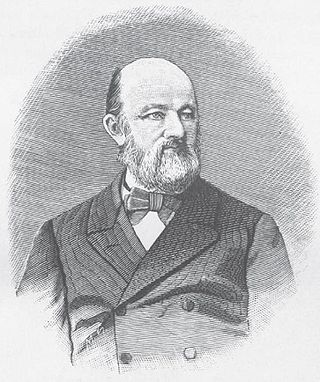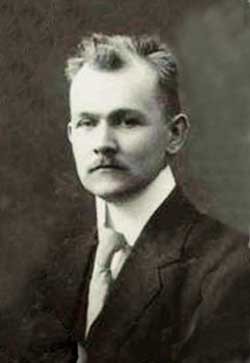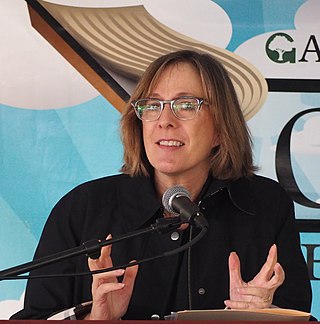
All Quiet on the Western Front is a semi-autobiographical novel by Erich Maria Remarque, a German veteran of World War I. The book describes the German soldiers' extreme physical and mental trauma during the war as well as the detachment from civilian life felt by many upon returning home from the war. It is billed by some as "the greatest war novel of all time".

Palomar Observatory is an astronomical research observatory in the Palomar Mountains of San Diego County, California, United States. It is owned and operated by the California Institute of Technology (Caltech). Research time at the observatory is granted to Caltech and its research partners, which include the Jet Propulsion Laboratory (JPL), Yale University, and the National Astronomical Observatories of China.

Jaan Kross was an Estonian writer. He won the 1995 International Nonino Prize in Italy.

Johann Heinrich von Mädler was a German astronomer.

Johann Friedrich Julius Schmidt was a German astronomer and geophysicist. He was the director of the National Observatory of Athens in Greece from 1858 to 1884. Julius Schmidt was tireless in his work, it was suggested by William Henry Pickering that he perhaps devoted more of his life than any other man to the study of the Moon. During his lifetime, he made some of the most complete lunar maps of the 19th century.

A Schmidt camera, also referred to as the Schmidt telescope, is a catadioptric astrophotographic telescope designed to provide wide fields of view with limited aberrations. The design was invented by Bernhard Schmidt in 1930.
The Digitized Sky Survey (DSS) is a digitized version of several photographic astronomical surveys of the night sky, produced by the Space Telescope Science Institute between 1983 and 2006.

Nicolaas Thomas Bernhard was an Austrian novelist, playwright, poet and polemicist who is considered one of the most important German-language authors of the postwar era. He explored themes of death, isolation, obsession and illness in controversial literature that was pessimistic about the human condition and highly critical of post-war Austrian and European culture. He developed a distinctive prose style often featuring multiple perspectives on characters and events, idiosyncratic vocabulary and punctuation, and long monologues by protagonists on the verge of insanity.

Bernhard Woldemar Schmidt was an Estonian optician. In 1930 he invented the Schmidt telescope, which corrected for the optical errors of spherical aberration, coma, and astigmatism, making possible for the first time the construction of very large, wide-angled reflective cameras of short exposure time for astronomical research.

The Battle on the Ice, alternatively known as the Battle of Lake Peipus, took place on 5 April 1242. It was fought largely on the frozen Lake Peipus between the united forces of the Republic of Novgorod and Vladimir-Suzdal, led by Prince Alexander Nevsky, and the forces of the Livonian Order and Bishopric of Dorpat, led by Bishop Hermann of Dorpat.

Hamburg Observatory is an astronomical observatory located in the Bergedorf borough of the city of Hamburg in northern Germany. It is owned and operated by the University of Hamburg, Germany since 1968, although it was founded in 1825 by the City of Hamburg and moved to its present location in 1912. It has operated telescopes at Bergedorf, at two previous locations in Hamburg, at other observatories around the world, and it has also supported space missions.

Naissaar is an island in Estonia. It is located in the Gulf of Finland, northwest of the capital city Tallinn, and is administratively part of Viimsi Parish. The island has an area of 18.6 square kilometres. It is 8 kilometres long and 3.5 kilometres wide, and lies about 8.5 kilometres from the mainland. The highest point on the island is Kunilamägi, which is 27 metres above sea level. The island consists predominantly of coniferous forest and piles of stones and boulders. In 2020, the island had a population of 17; in 2011 the island had about 35 permanent residents and some summer residents.

Richard Reinhard Emil Schorr, was a German astronomer.

The Heights Observatory is an Astronomical Observatory at The Heights School in Modbury Heights, Adelaide, South Australia.

Josef "Seppl" Veltjens was a German World War I fighter ace credited with 35 victories. In later years, he served as an international arms dealer, as well as a personal emissary from Hermann Göring to Benito Mussolini. He was awarded Pour le Mérite, the Royal House Order of Hohenzollern, and the Iron Cross.

Debra Lynn Dean is an American writer, best known for her 2006 novel, The Madonnas of Leningrad.

Great refractor refers to a large telescope with a lens, usually the largest refractor at an observatory with an equatorial mount. The preeminence and success of this style in observational astronomy defines an era in modern telescopy in the 19th and early 20th century. Great refractors were large refracting telescopes using achromatic lenses. They were often the largest in the world, or largest in a region. Despite typical designs having smaller apertures than reflectors, great refractors offered a number of advantages and were popular for astronomy. It was also popular to exhibit large refractors at international exhibits, and examples of this include the Trophy Telescope at the 1851 Great Exhibition, and the Yerkes Great Refractor at the 1893 World's Fair in Chicago.

Reigi is a village in Hiiumaa Parish, Hiiu County in northwestern Estonia.

A/S Merilaid & Co. was an Estonian shipping company. The firm was founded in Tallinn, Estonia on 18 February 1930. There were seven founding shareholders, most of whom were related by blood or marriage as descendants of Peeter All. Of the 7 founders, 6 were ship captains and 5 had worked in the Far East, in Vladivostok and/or Shanghai, for many years, and had avoided the turmoil of the Bolshevik or Communist Revolution, prior to returning home to a free Estonia. Estonia had been part of the Russian Empire since 1721 when Russia defeated Sweden in the Great Northern War. After World War I, and concurrent with the Russian Civil War, Estonia defeated Russia in the 1918–1920 War of Independence and became an autonomous nation after almost 200 years of Russian rule.
David Pearson Etter was an American poet. He was known for poems evoking small-town midwestern life. His most famous volume was written as 222 monologues in the voices of citizens of the imaginary community of “Alliance, Illinois,” which was based in part on his experiences living for many years in his adopted hometown of Elburn, Illinois.

















